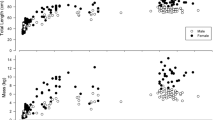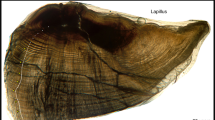Abstract
IT is most valuable to have Dr. Wallace's authoritative opinion (NATURE, March 7) that the scarcity in the North Sea of male plaice more than 8 years old is due to their own physiology and not merely to selective fishing. I suggest, however, to Dr. Wallace that this is no evidence of senile death, but of what we may conveniently call parental death. “The rapid decline in the relative number of males just after maturity” (the italics are Dr. Wallace's ) indicates that death is a consequence of their last and most productive spawning, and Atkinson's Barents Sea Statistics (Table II.) seem explicable only if 6/7 of the males there die after first spawning. We know that fresh-water eels spawn once and die, the conger also (Cunningham, Journ. M.B.A., vol. 2, p. 31) spawns once and dies, and Child (“Senescence and Rejuvenescence,” p. 302) states the same of the American salmon, adding, “the organism is undoubtedly in an advanced stage of senescence when sexual maturity is attained.” Minot and Child, by the great importance of their work, have permanently changed the meaning of the word “senescence” to signify progressive diminution in rate of metabolism, and they have shown that “senescence” starts at a maximum in the dividing ovum and falls rapidly with advancing age. I would plead that “senility” be still left in its original meaning to designate the negative growth in man which begins after full sexual maturity, and the like phenomenon where it is found to occur in other organisms; so that we have terms in which it is possible to discuss whether “senility” be really merely the latter stage of “senescence.” The death of a fish after spawning in the fulness of its power bears little resemblance to senile death, but is comparable to death of the spore-case when the spores are discharged, or of the wheat-stem when the grain is fallen; sexual reproduction primitively destroys the parent. The whole dividing protozoon disappears and the whole is utilised, but in metazoa a continually larger and more important somatic residue is wasted in death: in the conger, figures cited by Cunningham indicate that the heaviest roes approach to half the total weight, the residual body unutilised being therefore, at the lowest, equal in weight to the matricidal ovaries. So in many groups this loss of capital to the species is gradually avoided; the spent British salmon succeeds in returning to the sea and building up again in a year or two strength sufficient for a second spawning; the descendant of annual flowering plants takes on the biennial habit.
This is a preview of subscription content, access via your institution
Access options
Subscribe to this journal
Receive 51 print issues and online access
$199.00 per year
only $3.90 per issue
Buy this article
- Purchase on Springer Link
- Instant access to full article PDF
Prices may be subject to local taxes which are calculated during checkout
Similar content being viewed by others
Author information
Authors and Affiliations
Rights and permissions
About this article
Cite this article
BIDDER, G. The Mortality of Plaice. Nature 115, 495–496 (1925). https://doi.org/10.1038/115495a0
Issue Date:
DOI: https://doi.org/10.1038/115495a0
This article is cited by
-
The Biology of Old Age
Nature (1956)
Comments
By submitting a comment you agree to abide by our Terms and Community Guidelines. If you find something abusive or that does not comply with our terms or guidelines please flag it as inappropriate.



